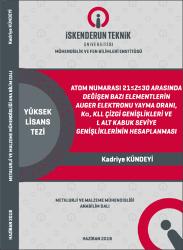| dc.contributor.advisor | Aylıçı, Nuray Küp | |
| dc.contributor.author | Kündeyi, Kadriye | |
| dc.date.accessioned | 2020-06-02T13:08:45Z | |
| dc.date.available | 2020-06-02T13:08:45Z | |
| dc.date.issued | 2019 | en_US |
| dc.date.submitted | 2019 | |
| dc.identifier.citation | Kündeyi, K. (2019). Atom numarası 21≤Z≤30 arasında değişen 3d grubu geçiş elementlerinin Auger elektronu yayma oranı, Kα, KLL çizgi genişlikleri ve L alt kabuk seviye genişliklerinin hesaplanması. (Yüksek Lisans Tezi). İskenderun Teknik Üniversitesi / Mühendislik ve Fen Bilimleri Enstitüsü, Hatay. | en_US |
| dc.identifier.uri | https://hdl.handle.net/20.500.12508/1335 | |
| dc.description.abstract | 3d gurubu geçiş elementleri kullanılarak üretilen alaşım ve bileşikler otomotiv sanayi, opto-elektronik uygulamalar, biyo-sensörler gibi pek çok kullanım alanına sahiptir. Bilim ve teknolojinin gelişmesinde geniş bir ürün yelpazesi sunan bu elementlerin dâhil olduğu malzeme yapısında oluşturacağı değişimler hakkında bilgi sahibi olabilmek için elementlerin elektronik yapısının incelenmesi gerekmektedir. Bunun sebebi, malzemeyi oluşturan atomların kimyasal bağ oluşturmasında en etkin faktörün valans (değerlik) bandı elektronik yapısının olmasıdır.3d gurubu geçiş elementlerinin valans bandı elektronik yapısının incelenmesinde K kabuğu floresans parametrelerinin ölçülmesi önemli bir yere sahiptir. Valans bandı M kabuğunda bulunan 3d gurubu geçiş elementlerinin kimyasal bağlanma olaylarında olduğu gibi elektronik yapıdaki herhangi bir değişim L kabuğunu ve buna bağlı olarak L kabuğundan K kabuğuna olan X-ışını geçişlerini etkileyecektir. Böylece X-ışını geçişlerindeki değişimler incelenerek atomların elektronik yapıları hakkında dolaylı olarak bilgi sahibi olunabilmektedir. Bu tez çalışmasında, Auger elektronu yayma oranı, Kve KLL çizgi genişlikleri ile L alt kabuk enerji seviyelerinin genişlikleri enerji ayrımlı X-ışını floresans yöntemi kullanılarak belirlenmiştir. Parametrelerin hesaplanması için elementler önce 59,5 keV’de γ ışınları yayan 241Am radyoaktif kaynak ile uyarılmış ve numunelerden yayınlanan X-ışınları, çözünürlüğü, 5,9 keV’de 150 eV olan Ultra-LEGe dedektörü yardımıyla sayılmıştır. Elde edilen foto-piklerin altında kalan alanlar parametrelerin hesaplamalarında kullanılmıştır. Yapılan çalışmalardan elde edilen bulgular önceki çalışmalarla karşılaştırılmıştır. Ayrıca tez kapsamında yapılan çalışmalar sonucu elde edilen parametreler, atomun karmaşık yapısının anlaşılmasında ortaya atılacak olan teorilerin geliştirilmesinde ve XRD ile XRF gibi malzeme karakterizasyonunda kullanılan cihazların üretimi ve tasarımında önemli rol oynamaktadır. | en_US |
| dc.description.abstract | The produced alloys and compounds by using 3d transition elements have many applications such as automotive industry, opto-electronic applications and bio-sensors. The electronic structure of these elements should be examined in order to have information about the changes in the structure of materials which offer a wide range of products in the developments of science and technology. The reason of this study is that the valence shell electronic structure is the most effective factor which constitute the chemical bonds. The measurement of K shell fluorescence parameters has an important position in the examination of the outer shell electronic structure of 3d transition elements. Any change in the electronic structure, as in the chemical binding effects occured in M shell of the 3d transition elements will affect the L sub-shells and consequently, the X-ray transitions from L to K shell. Thus, it can be get indirect information about the electronic structure of atoms by using the changes in X-ray transitions. In this thesis, the Auger electron emission rates, Kand KLL X-ray line widths and L sub-shell elevel widths were determined by using energy dispersive X-ray fluorescence method. First, the elements were irradiated by annular 241Am radioactive source which emittedray photons at 59,5 keV and the emitted X-rays were counted by Ultra-LEGe detector had a resolution 150 ev at 5,9 keV. The areas under the detected photo-peaks were used for the measurement of X-ray fluorescence parameters. The obtained results were compared with previous studies in the literature. Also, the measured parameters are important for the development of new theories to understand the complex structure of M shell and the designing and production of new devices for material characterisation such as XRD and XRF. | en_US |
| dc.language.iso | tur | en_US |
| dc.publisher | İskenderun Teknik Üniversitesi / Mühendislik ve Fen Bilimleri Enstitüsü / Metalurji ve Malzeme Mühendisliği Anabilim Dalı | en_US |
| dc.rights | info:eu-repo/semantics/openAccess | en_US |
| dc.subject | Floresans verim | en_US |
| dc.subject | Çizgi genişliği | en_US |
| dc.subject | Seviye genişliği | en_US |
| dc.subject | Auger elektronu | en_US |
| dc.subject | K X-Işını şiddet oranı | en_US |
| dc.subject | Fluorescence yield | en_US |
| dc.subject | Line width | en_US |
| dc.subject | Level width | en_US |
| dc.subject | Auger electron | en_US |
| dc.subject | K X-ray intensity ratio | en_US |
| dc.title | Atom numarası 21≤Z≤30 arasında değişen 3d grubu geçiş elementlerinin Auger elektronu yayma oranı, Kα, KLL çizgi genişlikleri ve L alt kabuk seviye genişliklerinin hesaplanması | en_US |
| dc.title.alternative | The calculation of the Auger electron emission rates, Kα, KLLline widths and L sub-shell level widths of elements within the range of atomic numbers 21≤7≤30 | en_US |
| dc.type | masterThesis | en_US |
| dc.contributor.department | Mühendislik ve Fen Bilimleri Enstitüsü | en_US |
| dc.relation.publicationcategory | Tez | en_US |
| dc.contributor.isteauthor | Aylıkçı, Nuray Küp | |
| dc.relation.index | İndeks Bilgisi Yok | en_US |
















